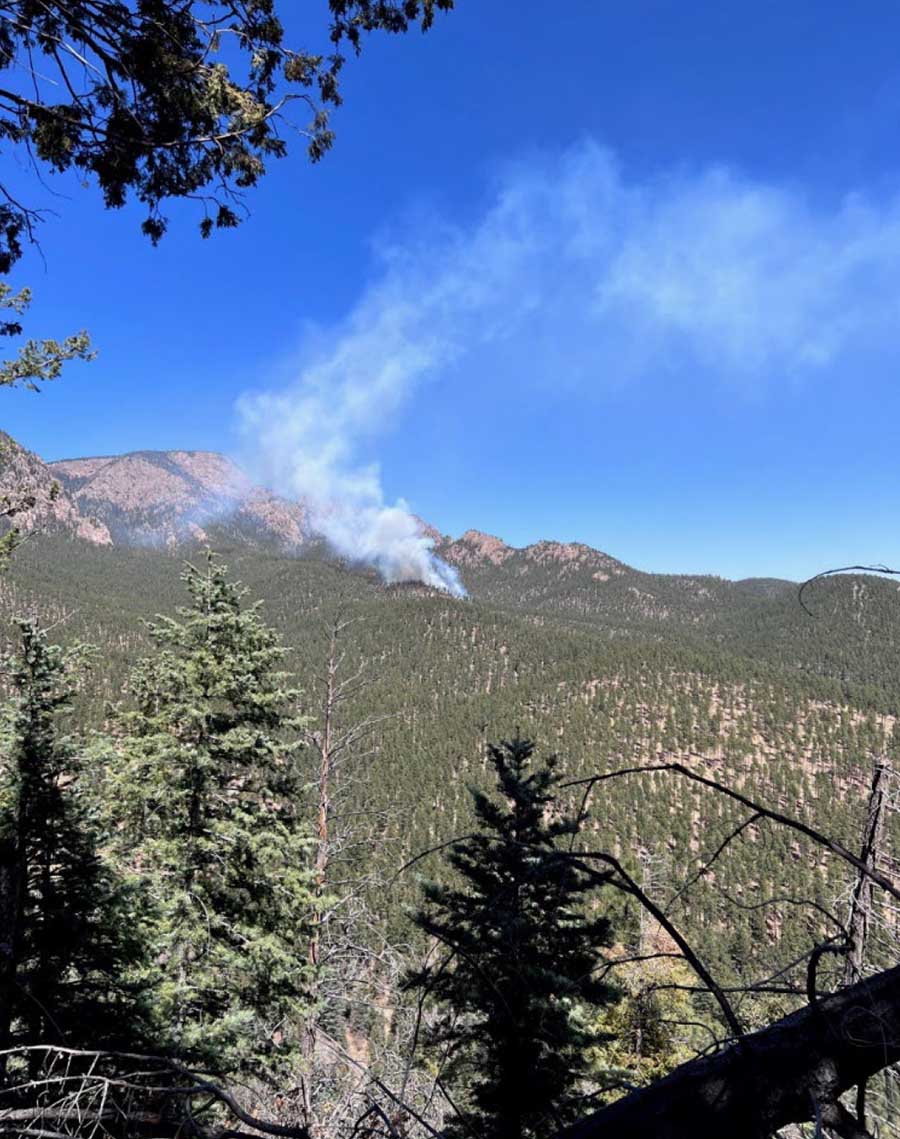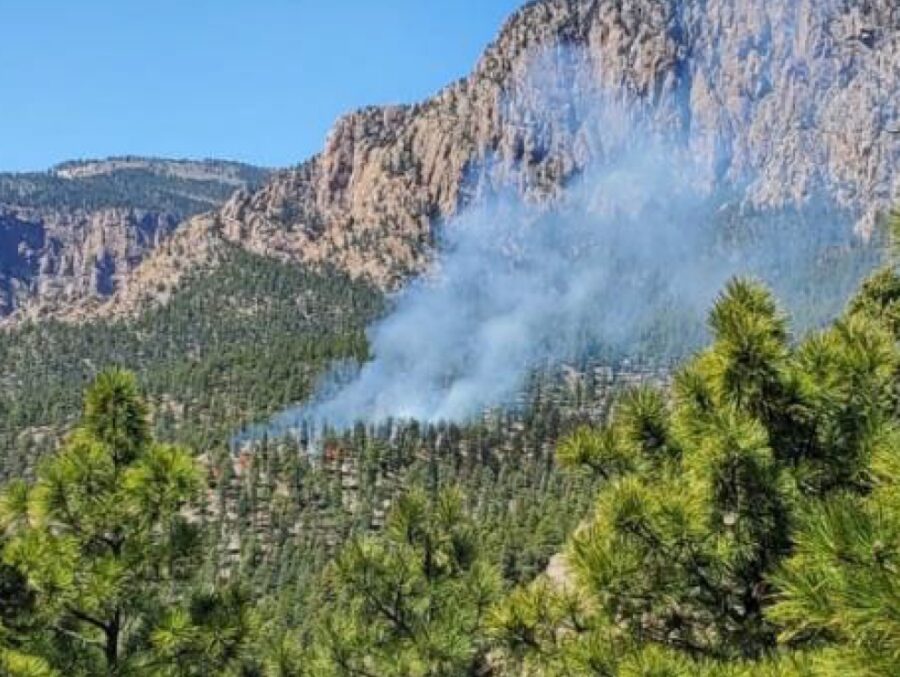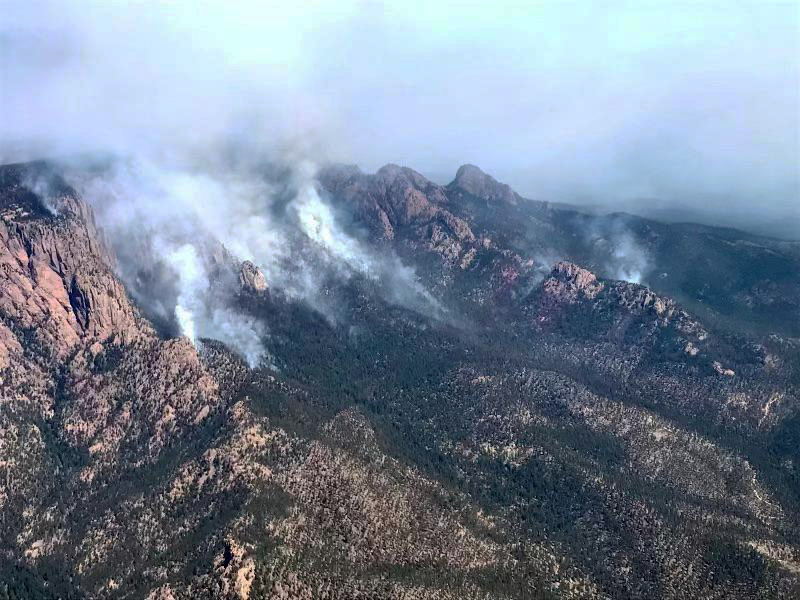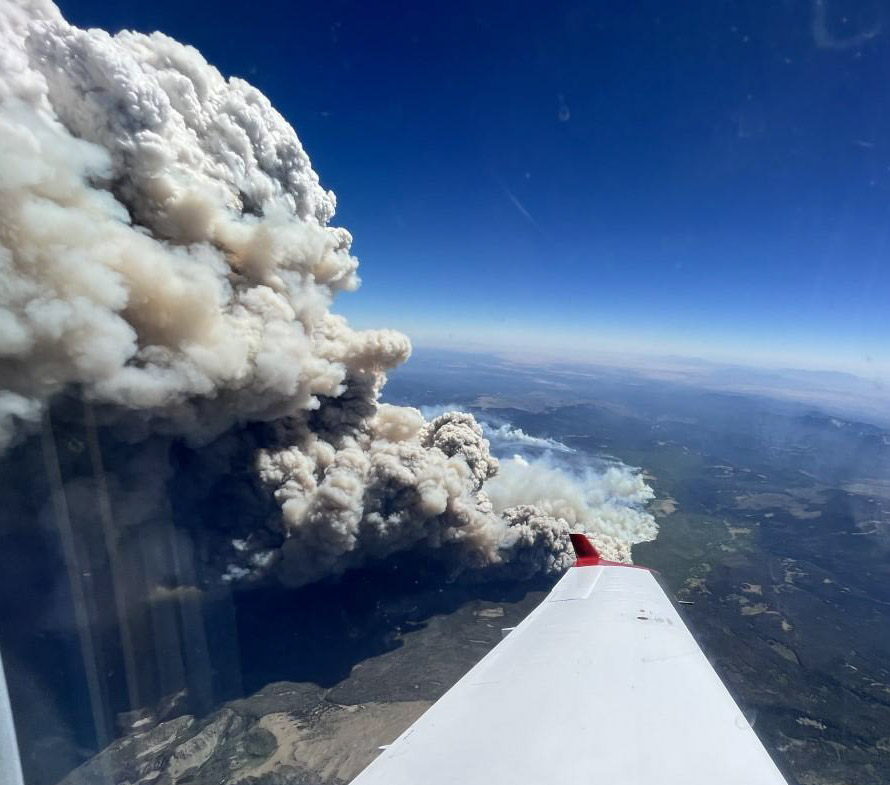
An 80-page report (4.7Mb) released by the U.S. Forest Service concluded that the management of the prescribed fire that escaped and merged with another escaped prescribed fire to become the largest wildfire in the recorded history of New Mexico, generally followed the approved prescribed fire plan for most but not all of the parameters. The people on the ground felt they were close to or within the prescription limits but fuel moistures were lower than realized and increased heavy fuel loading after fireline preparation contributed to increasing the risk of fire escape.
The prescribed fire on the Santa Fe National Forest in northern New Mexico east of the city of Santa Fe was one of the units within the Gallinas Prescribed Fire Project Area. The first burning activity in early October of 2017, was the ignition of piles of debris left after forest thinning projects. Less than expected snow allowed the fire to spread away from the piles over the next three months. In late December they began to suppress the fire, and on January 18, 2018 it was converted to a wildfire. A Facilitated Learning Analysis found that“communication” and “prescribed fire preparation and risk” were two common themes.
In a continuation of that large multi-unit project, on April 6, 2022 at 11:34 a.m. firefighters ignited the test fire on the Las Dispensas prescribed fire, expected to be 150 acres. At 12:34 p.m. the test was considered successful and the project commenced.

The first small spot fire occurred at 1:35, which was controlled. At 2:26 a quarter-acre spot fire was caught.
Radio communication with some of the personnel was discovered to be a problem. It was later found that Bravo Holding was using a separate “crew net” and were not monitoring the planned frequency.
Ignition stopped a couple of times as spot fires were suppressed, but by about 4 p.m. when the relative humidity dropped to 10 percent there were at least a dozen spots. At 4:06 the Burn boss requested contingency resources and at 4:15 as groups of trees began torching all resources were pulled off the fire due to the increasing fire intensity. At 4:25 Dispatch reported that the contingency resources were physically located in Taos, New Mexico at the Fire Summit (an annual training exercise). Taos is approximately 70 miles from the prescribed fire.
At 4:38 Dispatch advised the Agency Administrator that the Burn Boss and the Fire Management Officer recommend it be declared a wildfire — about four hours after the primary ignition began. The Agency Administrator made the wildfire declaration and at 4:50 the incident was named the Hermits Peak wildfire.

On April 22 the Hermits Peak Fire merged with the Calf Canyon Fire, another escaped prescribed fire on the Santa Fe National Forest. As of June 22 the blaze has burned more than 341,000 acres.
Weather
The prescription for broadcast burning required that the relative humidity be between 12 and 60 percent. The spot weather forecast issued by the National Weather Service at 8:53 a.m. on April 6 predicted the minimum RH would be between 9 and 13 percent, west winds 10 to 15 mph gusting to 25, and 54 to 58 degrees.
During the project on April 6 weather conditions were measured by a lookout once an hour using a hand-held Kestrel instrument. With that device the readings appeared to be within the prescription parameters except for the observations at 4 p.m. when it showed the RH had dropped to 10 percent.
From the report:
“Regarding temperature (dry bulb and wet bulb) and relative humidity, the observations recorded by the lookout showed a cooler and more moist bias when compared with other observations of weather and fire behavior on the site. Specifically, relative humidity readings taken from the Kestrel differed from what the relative humidity values should have been if calculated using the National Wildfire Coordinating Group standard tables for that elevation and the dry bulb and wet bulb observations. The relative humidity values recorded from the Kestrel provided values that are nearly 10 percent higher than those calculated.”
The recalculated RH at 4 p.m. was actually 6 percent, not 10 as shown on the Kestrel. One of the Firing Bosses also took readings and used the NWCG standard tables, which were similar to the recalculated values from the lookout’s Kestrel.
To summarize the weather, the forecast predicted the RH to be 9 to 13 percent, possibly below the prescribed 12 percent minimum, but it actually dropped as low as 6 percent, well below the prescription.
Fuels
Fine and heavy fuel loading increased in the years after the prescribed fire plan was developed, resulting from a combination of canopy opening from thinning (fine fuels) and fireline preparation (heavy fuels). This contributed to high fire intensity, torching, prolific spotting, and resistance to control.
The foliar fuel moistures were low and contributed to the transition from surface to crown fire. Fuel moisture samples taken from March 16 to April 3 showed a significant downward trend that contributed to the transition from surface to crown fire and increased spotting potential. Foliar moistures were listed to be sampled in the prescribed fire plan but were not part of the prescription.
The report’s conclusions, findings, and lessons learned
- There was no nearby Remote Automated Weather Station (RAWS) in working order representative of conditions at the burn site. If available, the data could have improved situational awareness.
- A thinning project in the burn area opened the canopy in some areas, allowing more sunlight which led to lower fuel moistures. Heavy ground fuels resulting from the construction of fireline for the burn project added to the fuel loading. This contributed to higher fire intensities, torching, spotting, and higher resistance-to-control.
- Low live fuel moistures facilitated the transition from surface fire to torching and spotting outside the unit boundaries.
- The prescribed fire plan mentioned that the Energy Release Component (ERC) which is an indication of the potential intensity of a fire, was to be monitored, but did not specify how the element would be used. On the date of the prescribed fire it was 37, far above average for the date which was 23. The highest ever recorded on that date was 41. Higher numbers indicate greater fire intensity.
- There was an underestimation of the minimum holding and contingency resources needed. After numerous spot fires occurred, the Burn Boss requested the contingency resources, but they were 70 miles away.
- A clear recognition and acknowledgment of long-term drought and climate factors versus short-term weather events would have led toward better situational awareness of the fire environment and could have resulted in more favorable outcomes.
- The test fire was initiated in an area of the unit that was not representative of the rest of the unit. On several occasions, both before the burn was ignited and after the test fire was considered and accepted, some personnel felt that the dry conditions would result in difficult burning conditions and an increase in risk, but they accepted the assignment.
- Consider requiring overhead, such as Firing Boss, Holding Boss and other staffed positions, to document support of the agreement with the Test Fire or the Go/No-Go decision.
- Administrative boundaries limited the selection of potential control lines. The prescribed fire unit designation followed boundary lines from private property and other land designations, such as wilderness, and not necessarily advantageous fuels changes or topography.
- Use the existing authority in the “Wyden Amendment” that allows managers of federal lands to spend funds to conduct treatments on adjacent non-federal lands to improve the viability of, and otherwise benefit, fish, wildlife, and other biotic resources.
- District fire employees perceived pressure to “accomplish the mission,” which may have led to taking greater risk.
- Records show the Prescribed Fire Burn Boss Type 2 (RXB2) performed as a fully qualified RXB2 at least 12 times since 2015.
- Invest in education opportunities for continued learning in science and technology specific to fire behavior and fire environment. Consider workshops tailored for prescribed fire practitioners that address today’s challenges related to environmental and social conditions.
- Prescribed fire programs and projects should invest in staffing, training, planning and other supporting resources commensurate with the priority and complexity of prescribed fire projects.
- Consider Incident Management Teams when implementing complex prescribed fire projects.
- Increase support for existing Burn Bosses by activating Planning Section functions when complexity warrants the additional capacity.
- Establish an interagency training facility, such as the National Interagency Prescribed Fire Training Center, that would be located in the Western U.S. and focus on the additional complexities involved with western fuel treatments.
- Learn from indigenous communities about cultural land management practices.
- Invest in education opportunities for continued learning in science and technology specific to fire behavior and fire environment. Consider workshops tailored for prescribed fire practitioners that address today’s challenges related to environmental and social conditions.
And this from the report
“We ask them to make up ground on long-needed and far-behind proactive restoration work while barely allowing time to recover from a previously taxing wildland fire response and preparing to respond yet again. We ask them to restore fire process to ecosystems that have evolved to burn, but many of which are now primed for extreme fire behavior due to our own decisions to exclude or suppress fire in these areas.
“To accomplish this level and frequency of prescribed fire on the landscape, we must ensure that practitioners have access to the best science, technology and tools, and that they are confident and practiced in their usage. We need an approach to planning and implementing prescribed fire that’s as robust as our Incident Management Teams’ response to wildfire.”
The 10-year plan
The 10-year plan released in January by the Forest Service for prescribed fire and other fuel projects calls for tripling the number of acres treated on National Forest System Lands in the West and other Federal, State, Tribal, and private lands in the West, increasing from about 2.5 million acres a year to 7.5 million.
Our take
The report said, “District fire employees perceived pressure to accomplish the mission, which may have led to taking greater risk.”
If they feel pressure now, how will they feel when the number of acres treated needs to increase substantially? Will there be a corresponding escalation in Burn Bosses, Holding Bosses, full time prescribed fire planners, NEPA compliance capacity, crews, and weather windows?


Any agency administrator that pressures, coerces or threatens anybody to burn should be removed and charged with intimidating/threatening a public official. Personally, I will file a police report if it happens to me. Immediately!
Where do we draw the line on trying to write 800 hours of fuels work into a firefighter series pd?
We simply don’t. That is absolutely unfeasible. Might as well make it a million hours.
I agree.
I removed/scrubbed RXB2 from my Red card today. No more.
Hmmmm….. 2 RX’s that escaped and combined for 340,000(+) acres, along with numerous other escaped RX’s in other states/regions this year.
Can we PLEASE have H-Pay for RX now???
I don’t buy into fuel loads increasing??? Burn plans are made to reflect fuel loading after thinning, etc. With time pine needles turn red and eventually fall off, putting fine fuels closer or on the ground, which reduces fire behavior, I am sure most pine needles were on the ground, which would reduce intensity….I did burn in Las dispensas before retirement and back in 18, red needles still on boles were already minimum back then. So I don’t buy fuel loading increasing…
What a shame, how long have we been doing this? How many lessons do we need to learn and how many times? I get it that Rx burning is complicated and challenging, but when conditions are marginal, there need to be decisions made on the side of caution. Not having contingency resources nearby or on scene is negligent. We can do better.
I’m always hearing about how fire supression created this mess, but I hear zero reporting about how bark beetle infestation created the tinderbox in our forests by killing every other tree in them. As an avid camper/hiker, I have seen bark beetle devastation for many years, and I always thought that was the main cause of these wildfires tearing through the west now. I heat with a wood stove as well, and I also see that most logs I get are bark beetle damaged. Why don’t any of these articles ever mention that? Could it be because the bark beetle population explosion is a direct result of climate change, and the fossil fuel industry is busy trying to control the narrative, as they always do?
My understanding is that forest overgrowth caused by fire suppression has enabled the bark beetles to spread more widely than they would normally be able to by removing the breaks in the trees there would historically have been. So fire suppression has at least contributed to that problem.
You are pretty close to describing the facts, but look up how Bark Beetles get started in the first place. Think about why the huge Bark Beetle infestation started and what forest management practices no longer are practiced. If you will do these things and still find that global warming, and stopping all fires is to blame then you need to review what forest management really means. Keep thinking, it’s good for you.
A prescribed fire training center is way overdue for the Western United States. PFTC (Prescribed Fire Training Center) in Florida is on of the best training centers for fire practitioners in the Universe. Having another Center in the West would be perfect for new or beginning practitioners; This would be in alignment with our new goals of burning and treating more acres across the board for DOI and FS. No other training goes into detail with assignments and groups to put fire on the ground in a professional atmosphere and from an ecological standpoint. West Coast PFTC for the Northwest would be the best case scenario.
This report highlights the need that burn plans can’t just live on a shelf, they’re living documents that need technical review up until the test fire (complexity, fuels, weather, contingency resources, coms plan, on site staff experience….). We as a profession have dumbed down the FIRB qual, what is the minimum qualification for a Holding Boss? We are expected to push fire through some of the most difficult properties in the world with an antiquated structure. Sending staff to the SE to practice on frequently fire maintained sites on relatively flat ground does not prepare you for reintroducing fire to long unburned sites at scale, wildland rural intermix, and topographical challenges we face from years of neglect. Hopefully as agencies we can come together out of this and modernize our RX fire structure to reflect the National challenges we have ahead of us. To all the woods burners out there, y’all are my heroes!
Amen.
Any single resource boss can function as a holding boss is my current knowledge. Seems like me might want to think about that more.
Keep it simple. If the situation is too complex and variable, empower people to just say no.
April 6, “2021”?
Bill, the answer your last question…. We all know the answer to that, it’s no. Even if we hire a bunch of folks, the agency is still 7-10 years out from getting those folks experience and qualifications to be good fire practitioners.
Look at the numbers…. The Federal land management agencies can’t keep up with wildfire suppression on an average of 1.2 million burned acres a year (NIFC 10 year average). This is with the help of cooperators, contractors, and ADs. The USFS wants us to burn 5-7 times that. When are we going to be honest and open about our expectations, especially with the public?
We need a social, political, and marketing campaign on the scale of Smokey in the 50s, as well as a workforce on the scale of the CCC during the depression to accomplish these goals and expectations.
They sure seem to be getting lost in the weeds.
Smoking week right ok right
Why no talk of of the cal canyon. The calf canyon got out at the same time and was “caught” at 1.5 ac. Then got out a second time weeks later and was never caught. There was a heat signature of the calf canyon fire on all of the hermit peak fire maps. I feel bad for the locals.
Perceived pressure because forest administrators need to get acres treated to get their large bonuses?
Is anyone looking into the incentive structure and how we incentivize bad behavior in the land management agencies?
Yeah, actually. I am doing a FOIA on it that just got bumped from FS HR to USDA. I’ll send you an email.
Everyone knows the old Kestrel trick to stay in prescription. Also, test fires in unrepresentative areas of the burn. Everyone knows these tricks to keep a burn “in prescription” when you are over the edge.
And now look at all the destruction caused, entire prescribed fire program shit down, all so some forest admin folks can get their $20k bonuses for the year. It’s idiotic.
There are no $20000 bonuses
There could easily be 20k bonuses for SES positions like regional foresters. This link explains how much SES can get. Forest supervisors can get up to 10% of their salary as an award if I am reading the policy on General Schedule properly. That could easily be anywhere from 10-15k +
https://www.opm.gov/policy-data-oversight/senior-executive-service/compensation/
I got my employees bonuses last year. Any bonus over $2000 required Regional Forester Approval. I think the max was like 10 with Secretary approval or something like that.
We government employees aren’t in it to get rich.
I feel bad for the folks on the ground just trying to get work done. The report suggestions are lots of additional costs and pie in the sky. Yea, order up that Type One Team for a burn, I guess that reviewer was on a Team.
My boss specifically said “pie in the sky” about the raises before we got them. If they want to treat the acres they are talking about, they are going to need more organization than we have now. We are talking about Forest supt. and SES bonuses, no one is talking about bonuses below that level.
The U.S. Forest Service does not give bonuses to the folks on the ground for doing Prescribed fire, or much less for anything else!!!…I was heavily involved in Rx fire in Northern New Mexico from 1982- 2018, and never was there incentives to do these, mostly negative things if something went wrong..
I think *if* there is any evidence that there are bonuses given for targets, the real money is not going to folks on the ground at all.
Doing RX either above or below prescription with the sole intent of treating a pre-established number of acres is just a piss poor reason to do it. Even prescribed fire under perfect conditions creates risk. Boots on the ground shouldn’t be asked to take on that risk unless we are doing it to substantially improve conditions. Whether that is related to reducing wildfire intensity in WUI or improving habitat etc.
The thing is, once you get to SES level, which is the regional forester level and up, they are allowed to get some very substantial percentages of their salaries added as an award. Forest supervisors have, at least in the past also gotten substantial awards. There is always a papertrail of why an award is given. I have to do a justification as well as a supervisor, if I want to give my employees an award. I submit it and it goes into a file somewhere.
I think it is critically important right now to make sure we are looking at where the pressure to do a given burn comes from at the 20,000 foot level. I have yet to see an FLA or fatality report that gets very far above the ground in a meaningful way.
Otherwise, we are going to start seeing RXB quals treated with the same apprehension that people had with IC quals after 30 mile.
We need a discussion that can address systemic management issues leading to a lost RX before it happens without having the folks on the ground afraid of ending up under the bus because they were apprehensive to light under certain conditions and did so anyway. Non field going upper management have wanted to captain the ships we are rowing, they can go down with them as well.
I’m talking forest supervisor level. Of course there isn’t anything for the people actually doing the work.
I was a Forest Supervisor for 7 years. The most I ever got was $1800 cash award. And I had outstanding and superior ratings. As far as I know, there are no big bonuses for district rangers and forest supervisors